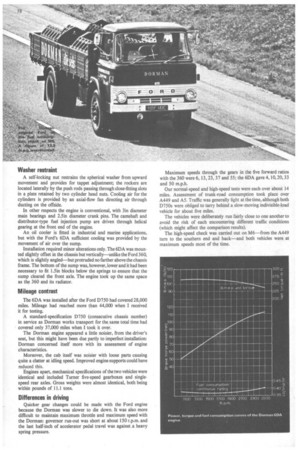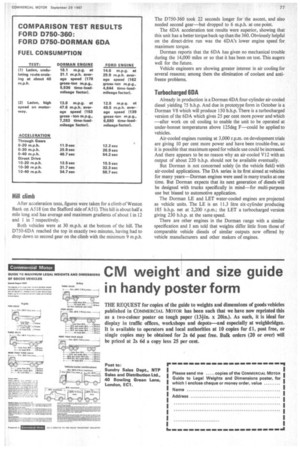Dorman engines for trucks
Page 76

Page 78

Page 79

If you've noticed an error in this article please click here to report it so we can fix it.
A. J. P. Wilding tests air-cooled model in Ford D750
SERIOUS efforts are to be made by W. H. Dorman and Co. Ltd., Stafford, to enter the vehicle industry with their various ranges of diesel engine. And it will be of particular interest to vehicle users that Dorman considers an air-cooled diesel to be especially suitable for goods-vehicle application.
The firm has been testing one of its 107 b.h.p. six-cylinder units in a Ford D750 and I have carried out independent tests, of this development vehicle and, for comparison, of a standard D750. The Dorman-engined vehicle's fuel consumption and performance were better than those of the D750 but it was not quite as fast.
The Dorman used: a 6DA unit from a range of four-, sixand eight-cylinder diesels introduced about 18 months ago. More than 500 6DA multi-purpose diesels have been built.
Comparison Maximum net output of the D750 6DA was 107 b.h.p. at 2,500 r.p.m., although DAs for industrial use are producing 112 b.h.p. net at this speed. Maximum net torque was 2661b.ft. at 1,200 r.p.m. compared with 113 b.h.p. net at 2,800 r.p.m. and 2621b.ft. net at 1,600 r.p.m. for the usual D750 360 cu.in. engine.
Bore was 105mm (4.134in.) and stroke 120mm (4.724M.), making the cubic capacity 6.23 litres (380 cu.in.). Compression ratio was 17.8 to 1 and dry weight 1,050Ib (about the same as the Ford 360 with radiator and coolant).
The 6DA is a direct-injection engine and the individual cylinder barrels are extensively finned to promote cooling. Each cylinder barrel carries its own aluminium-alloy head which has cast-iron valve-seat inserts.
Pressed-steel bucket rockers are pivoted in their centres on simple inverted half-spherical washers mounted on studs screwed into the top decks of the cylinder heads.
Washer restraint
A self-locking nut restrains the spherical washer from upward movement and provides for tappet adjustment; the rockers are located laterally by the push rods passing through close-fitting slots in a plate retained by two cylinder head nuts. Cooling air for the cylinders is provided by an axial-flow fan directing air through ducting on the offside.
In other respects the engine is conventional, with 3in diameter main bearings and 2.5in diameter crank pins. The camshaft and distributor-type fuel injection pump are driven through helical gearing at the front end of the engine.
An oil cooler is fitted in industrial and marine applications, but with the Ford's 6DA sufficient cooling was provided by the movement of air over the sump.
Installation required minor alterations only. The 6DA was mounted slightly offset in the chassis but vertically—unlike the Ford 360, which is slightly angled—but protruded no farther above the chassis frame. The bottom of the sump was, however, lower and it had been necessary to fit 1.5in blocks below the springs to ensure that the sump cleared the front axle. The engine took up the same space as the 360 and its radiator.
Mileage contrast
The 6DA was installed after the Ford D750 had covered 28,000 miles. Mileage had reached more than 44,000 when I received it for testing.
A standard-specification D750 (consecutive chassis number) in service as Dorman works transport for the same total time had covered only 37,000 miles when I took it over.
The Dorman engine appeared a little noisier, from the driver's seat, but this might have been due partly to imperfect installation: Dorman concerned itself more with its assessment of engine characteristics.
Moreover, the cab itself was noisier with loose parts causing quite a clatter at idling speed. Improved engine supports could have reduced this.
Engines apart, mechanical specifications of the two vehicles were identical and included Turner five-speed gearboxes and singlespeed rear axles. Gross weights were almost identical, both being within pounds of 11.1 tons.
Differences in driving
Quicker gear changes could be made with the Ford engine because the Dorman was slower to die down. It was also more difficult to maintain maximum throttle and maximum speed with the Dorman: governor run-out was short at about 150 r.p.m. and the last half-inch of accelerator pedal travel was against .a heavy spring pressure. Maximum speeds through the gears in the five forward ratios with the 360 were 6, 13, 23, 37 and 55; the 6DA gave 4,10,20,33 and 50 m.p.h.
Our normal speed and high-speed tests were each over about 14 miles. Assessment of trunk-road consumption took place over A449 and A5. Traffic was generally light at the time, although both D750s were obliged to tarry behind a slow-moving indivisible-load vehicle for about five miles.
The vehicles were deliberately run fairly close to one another to avoid the risk of each encountering different traffic conditions (which might affect the comparison results).
The high-speed check was carried out on M6—from the A449 turn to the southern end and back—and both vehicles were at maximum speeds most of the time. Hill climb After acceleration tests, figures were taken for a climb of Weston Bank on A518 (on the Stafford side of A51). This hill is about half a mile long and has average and maximum gradients of about 1 in 12 and 1 in 7 respectively.
Both vehicles were at 30 m.p.h. at the bottom of the hill. The D750-6DA reached the top in exactly two minutes, having had to drop down to second gear on the climb with the minimum 9 m.p.h. The D750-360 took 22 seconds longer for the ascent, and also needed second gear-but dropped to 6 m.p.h. at one point.
The 6DA acceleration test results were superior, showing that this unit has a better torque back-up than the 360. Obviously helpful on the direct-drive run was the 6DA's lower engine speed for maximum torque.
Dorman reports that the 6DA has given no mechanical trouble during the 14,000 miles or so that it has been on test. This augers well for the future.
Vehicle engineers are showing greater interest in air cooling for several reasons; among them the elimination of coolant and antifreeze problems.
Turbocharged 6DA Already in production is a Dorman 4DA four-cylinder air-cooled diesel yielding 75 b.h.p. And due in prototype form in October is a Dorman V8 which will produce 150 b.h.p. There is a turbocharged version of the 6DA which gives 25 per cent more power and which -after work on oil cooling to enable the unit to be operated at under-bonnet temperatures above 125deg F-could be applied to vehicles.
Air-cooled engines running at 3,000 r.p.m. on development trials are giving 10 per cent more power and have been trouble-free, so it is possible that maximum speed for vehicle use could be increased. And there appears to be no reason why an air-cooled V12 with an output of about 220 b.h.p. should not be available eventually.
But Dorman is not concerned solely (in the vehicle field) with air-cooled applications. The DA series is its first aimed at vehicles for many years-Dorman engines were used in many trucks at one time. But Dorman expects that its next generation of diesels will be designed with trucks specifically in mind-for multi-purpose use but biased to automotive application.
The Dorman LE and LET water-cooled engines are projected as vehicle units. The LE is an 11.3 litre six-cylinder producing 185 b.h.p. net at 2,200 r.p.m.; the LET a turbocharged version giving 230 b.h.p. at the same speed.
There are other engines in the Dorman range with a similar specification and I am told that weights differ little from those of comparable vehicle diesels of similar outputs now offered by vehicle manufacturers and other makers of engines.




































































































































































